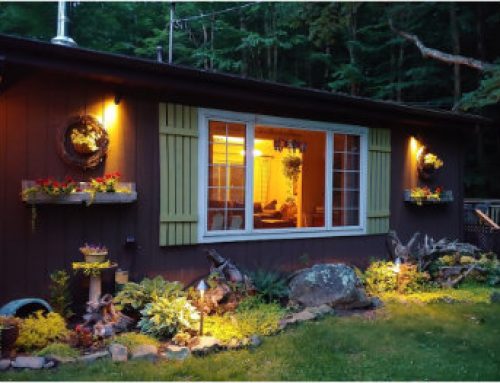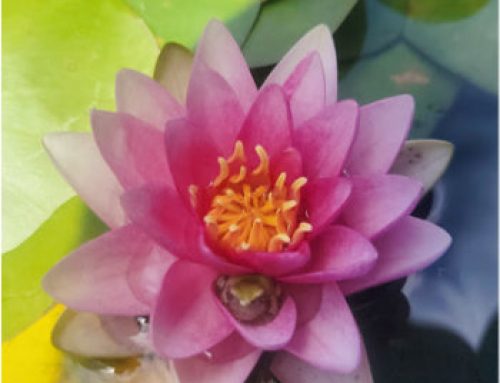
Adding Beauty and Functionality
Aquatic plants in a pond not only helps with the overall beauty of a pond but provide benefits that are a natural part of the ecosystem pond. They help increase oxygen for your fish, provide shade for fish on those hot days, and provide filtration to keep healthy water quality. Their presence in your pond will also help keep algae spread under control. The shade that some plants provide reduces incoming light which limits algae photosynthesis and the filtration they provide prevents string algae from forming.
When it comes to choosing what plants to add to your pond you have several options. Aquatic plants are divided into 3 categories which include Submerged plants, Shallow-water marsh plants & Floating plants.
Submerged PlantsIt is usually easiest to add submerged plants to your pond by keeping them in a pot. This allows you to set the plant in the bottom of the pond without digging up and gravel. It will also make it easier to divide or cut back the plant if it begins to take over the entire pond. Submerged plants are known as oxygenating plants and do a fantastic job of removing excess nutrients from your pond water. Below are a few examples of submerged aquatic plants that will be a great addition to your pond.
American Waterweed
 The American Waterweed (elodea) lives entirely underwater with exception to small white flowers that bloom at the surface of the water. These will grow in a range of conditions from shallow to very deep water. They provide an abundance of shade for your fish and a great at utilizing dissolved Co2 in the water. They can even continue to grow if they are unrooted and they are an attractive easily kept pond plant.
The American Waterweed (elodea) lives entirely underwater with exception to small white flowers that bloom at the surface of the water. These will grow in a range of conditions from shallow to very deep water. They provide an abundance of shade for your fish and a great at utilizing dissolved Co2 in the water. They can even continue to grow if they are unrooted and they are an attractive easily kept pond plant.
Fanwort
 Fanwort is another submerged aquatic plant that forms dense mats on the surface of the water. Their underwater leaves are delicate and are fan-like. On average the leaves grow to be 2 inches across and arrange in opposite pairs on the stem. They bloom with white flowers from May through September. They are fast-growing oxygenators that require a great deal of light. They can be an invasive plant that grows up to 1 inch per day so keep an eye on it and cut it back if it begins to take over your pond.
Fanwort is another submerged aquatic plant that forms dense mats on the surface of the water. Their underwater leaves are delicate and are fan-like. On average the leaves grow to be 2 inches across and arrange in opposite pairs on the stem. They bloom with white flowers from May through September. They are fast-growing oxygenators that require a great deal of light. They can be an invasive plant that grows up to 1 inch per day so keep an eye on it and cut it back if it begins to take over your pond.
Shallow Water Marsh Plants
These types of plants do best when planted on the edge of your pond in a shallow area. They will prosper in just a few inches of water and grow very lush.
Water Iris
 The Water Iris is a very popular plant for pond owners as they come in a variety of species. Their leaves are sharp, and some species will produce a range of beautiful flower colors from blue, yellow, or white. These plants can also be invasive so usually, it is easiest to add them to your pond in pots. Most of these plants will grow great in either full sun or partial shade.
The Water Iris is a very popular plant for pond owners as they come in a variety of species. Their leaves are sharp, and some species will produce a range of beautiful flower colors from blue, yellow, or white. These plants can also be invasive so usually, it is easiest to add them to your pond in pots. Most of these plants will grow great in either full sun or partial shade.
Horsetail
 This is another fast-growing plant that creates a skinny green stem. They will grow great in a partial shade pond so if you have some tree cover this may be a smart choice.
This is another fast-growing plant that creates a skinny green stem. They will grow great in a partial shade pond so if you have some tree cover this may be a smart choice.
Umbrella plants
 Just like the name suggests, these plants have umbrella-shaped leaves at the end of their long stalks. They typically strive in more tropical regions so if you live in a colder climate they should be brought in during the winter to survive.
Just like the name suggests, these plants have umbrella-shaped leaves at the end of their long stalks. They typically strive in more tropical regions so if you live in a colder climate they should be brought in during the winter to survive.
Floating plants
These are great pond additions, they can be true free-floating plants that prosper entirely floating on the surface and unattached to roots. There are also floating plants that have roots stemming from the bottom of the pond and are attached to the leaves that float above the surface. Both provide an abundance of shade for your fish, help control the algae, and are relatively easy to care for. Floating plants additionally remove much of the existing nitrogen and phosphates in your pond water doing an excellent job filtering.
Water lilies
 When it comes to Aquatic plants, Water lilies are a top choice for pond owners. They are a floating plant that has attached roots that stem from the bottom of the pond. They strive in nearly any region and in any season in North America. They are best if potted and placed at the bottom of your pond at a 45-degree angle, so consider slightly leaning in against the bottom shelf of your pond. The surface will have an array of leafy coverings and have beautiful colorful flowers that bloom in the spring and summer.
When it comes to Aquatic plants, Water lilies are a top choice for pond owners. They are a floating plant that has attached roots that stem from the bottom of the pond. They strive in nearly any region and in any season in North America. They are best if potted and placed at the bottom of your pond at a 45-degree angle, so consider slightly leaning in against the bottom shelf of your pond. The surface will have an array of leafy coverings and have beautiful colorful flowers that bloom in the spring and summer.
Water Hyacinth
 The Water Hyacinth species is an annual plant in colder regions of North America but is actually a perennial in the warmer parts of the continent. They bloom blue and purple flowers and their roots are nestled right beneath the leaves under the water making this an unattached aquatic plant. They do an excellent job filtering your pond of excess nutrients.
The Water Hyacinth species is an annual plant in colder regions of North America but is actually a perennial in the warmer parts of the continent. They bloom blue and purple flowers and their roots are nestled right beneath the leaves under the water making this an unattached aquatic plant. They do an excellent job filtering your pond of excess nutrients.
Lotus
 Very similar to water lilies, the lotus is also a terrific addition to any fish pond. The Lotus flower is very beautiful and fragrant. Their leaves grow very large and are another floating plant that is great for providing shade for your fish. These plants are attached to roots that are planted at the bottom of the pond. Be cautious when deciding to plant as Lotus have a high growth rate and is best suited for large ponds.
Very similar to water lilies, the lotus is also a terrific addition to any fish pond. The Lotus flower is very beautiful and fragrant. Their leaves grow very large and are another floating plant that is great for providing shade for your fish. These plants are attached to roots that are planted at the bottom of the pond. Be cautious when deciding to plant as Lotus have a high growth rate and is best suited for large ponds.
Water Lettuce
 Water Lettuce is another unattached warm climate aquatic plant. It has compact leaf clusters that float on the surface of the water with compacted roots that form beneath them. Also is a good Shade provider for fish.
Water Lettuce is another unattached warm climate aquatic plant. It has compact leaf clusters that float on the surface of the water with compacted roots that form beneath them. Also is a good Shade provider for fish.



